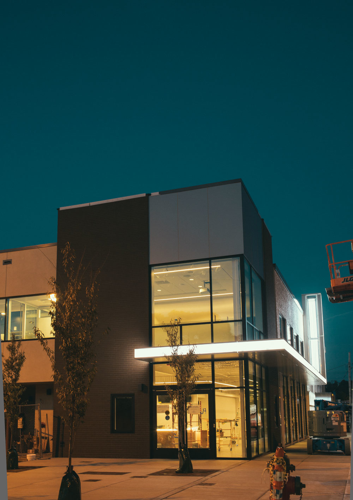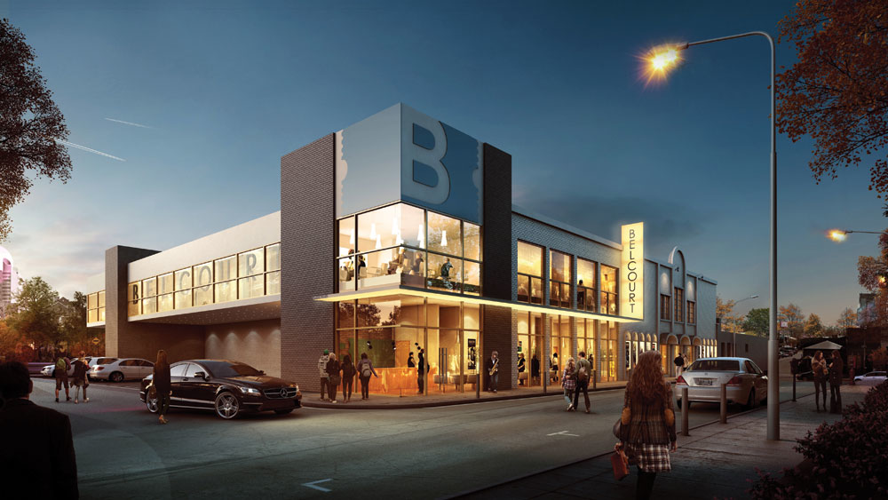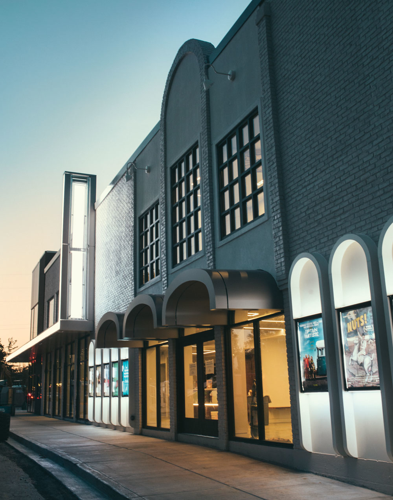
The Belcourt in July 2016, while under construction
Planks. Decades-old wooden planks.
It’s May, and The Belcourt Theatre is in the middle of colossal renovations. The area that once served as the nonprofit theater’s bar and concessions stand has been gutted. Now planks that were nailed across a doorframe at some point in the 20th century are visible amid the crumbling plaster, all that separates the storied Nashville arthouse from The Villager Tavern next door.
When The Belcourt, then called the Hillsboro Theatre, opened in 1925, the part of the building that is now The Villager — a dingy if respectable beer-only Hillsboro Village watering hole — served as the theater’s 21st Avenue entrance. That piece of the property was sold off two years later and became the White Eagle Tavern, which eventually became The Villager. And for decades, these wooden planks — which appear to have been hammered across this long-hidden doorframe in a slapdash fashion — languished unseen behind The Belcourt’s walls. Until this year, when those walls came down.
On Christmas Eve 2015, The Belcourt ended its annual run of Frank Capra’s classic Christmas feature It’s a Wonderful Life before closing its doors to the public. Over the next few months, there would be off-site screenings co-presented by The Belcourt at fellow cinema-revering local institutions like Third Man Records, OZ Arts Nashville and Belmont University. But throughout the spring and into the summer, there would be no paying customers at The Belcourt property, just those involved with the construction, theater staff and those lucky enough to be granted hardhat tours. Tours like the one being granted to the Scene on this particular May afternoon.
Sparks fly and jackhammers clang as a small group of visitors, led by Belcourt executive director Stephanie Silverman, works its way through a site that looks completely alien, even to those of us who’ve been in the theater dozens of times as patrons. Silverman has to shout over the construction noise to describe where the bathrooms will be, what the lobby will look like, how big the light- and noise-canceling vestibules at the theater entrances will be.
Programming director Toby Leonard is also present on the tour. He’s worked at the theater since 2000, when, after coming dangerously close to shuttering for good, The Belcourt reopened thanks to the efforts of the Belcourt YES! campaign. According to Leonard, on particularly busy nights at The Villager, the odor of cigarette smoke would slip through the walls, slither between those planks and make its way into the lobby, where it would wait for Belcourt opening staff the following morning.
Those rickety old boards are emblematic of what’s been going on at The Belcourt for years: electrical, plumbing and air-conditioning systems leagues behind where they should be; two small bathrooms that weren’t ADA compliant; cracks and leaks and plastic tarps rigged to channel rainwater into buckets; films that are still selling tickets being taken out of rotation simply because there aren’t enough screens in the place to justify keeping them around.
“It was saved as an institution,” Silverman later says, referring to the YES! campaign that brought The Belcourt back from the brink of demise, “but now we have to save it as a structure, too.”

Rendering: Tuck-Hinton Architecture
On Friday, July 22, The Belcourt will open its doors to the public following a press conference and ribbon-cutting ceremony with Mayor Megan Barry. The institution will not reopen to the public with a concert or a party, but simply by diving right back into what it and its staff do best — showing films.
“We just need to be open, man,” Leonard says with a laugh. It’s now early July, and he’s speaking with the Scene from The Belcourt’s temporary offices on Charlotte Avenue. “We could spend a whole lot of time and energy on getting such-and-such to come pay a visit to Nashville or do some event, but there’s plenty of time for that.”
It’s a hell of a reopening program that Leonard & Co. have cooked up. Its first weekend back, the arthouse will show films including Absolutely Fabulous: The Movie, the follow-up to the hit Britcom of the same name; Wiener-Dog from controversial auteur Todd Solondz (see our review here); punk rock thriller Green Room; The Music of Strangers, a doc about Yo-Yo Ma’s Silk Road Ensemble; and Akira Kurosawa’s epic Ran. When asked what he’s most excited about, Leonard says, “I’ve gotta treat all of my children equally.” But then he admits it’s a pair of wuxia features — that is, a fantastical genre of Chinese martial-arts films — by writer-director King Hu that he’s elated to have squeezed into opening weekend: 1967’s Dragon Inn and 1971’s A Touch of Zen, forerunners to the likes of Crouching Tiger, Hidden Dragon and House of Flying Daggers.
When patrons approach the building for those opening-day screenings, which start at 12:30 p.m., it’s a different facade — at first blush, radically different — they’ll see. For one, they’ll enter the building not through the entrance facing Belcourt Avenue, but rather through a pair of glass doors that face the parking lot and its brand-new plaza. They’ll be greeted by a larger, repositioned box office and a lobby that, at roughly 1,500 square feet, is about twice the size of the one visitors last saw.

The new lobby, with the concessions stand visible on the left and the donor wall on the right
The design of The Belcourt’s new lobby is sleek and modern but tasteful, with suspended overhead lights that jut inward at certain points to indicate the location of each theater entrance. Screens throughout the lobby will display showtimes, and a significantly upgraded concessions stand — which will now serve wine on tap in addition to its other wines, beer and cocktails — is positioned between the theater entrances. Wooden signs along the lobby wall feature the names of those who have given what are referred to as “leadership gifts” — that is, donations of $10,000 or more in the nonprofit’s campaign to raise $5 million for the overhauls. The signs, like the benches in the lobby’s new alcove space, were made from salvaged rafters that once held up the building’s now-lower roofline.
That approach to maintaining the historic elements of the building while expanding and reinforcing them is one that is apparent throughout The Belcourt’s new design.
“Preservation is not just leaving something alone, especially in a building that’s still active, that people want to use on a daily basis, that has to be welcoming to everybody,” says Silverman. “I think people got that if we really wanted to continue to stand and not just be a museum or something static, but something that’s still living and breathing and serving the community, we have to shore it up.”
A big part of being welcoming to everybody, as Silverman puts it, is something as simple as drastically improving the building’s insufficient restrooms. The bathrooms were not handicap accessible, but due to the historic nature of the building, they were grandfathered in under city codes. That meant, in some cases, Belcourt staff had to direct disabled patrons to use the restrooms at other establishments in the area.

Says Belcourt board member, financial adviser and dedicated patron H.G. Webb, “Ten years ago I started jumping up and down, ‘We have to do something about the ladies’ restroom! This is horrible!’ ” Webb’s name is among those on the lobby’s donor signs. A longtime Nashvillian — he graduated from Vanderbilt in 1963 — Webb’s deep love for The Belcourt and its staff is unmistakable.
“This wonderful old building was literally falling around our heads, and coming to the point of actually being dangerous. Plus, the last 10 years, we averaged spending $80,000 a year on maintenance. Just sticking Band-Aids on it — just duct tape and emergency repairs to the air-conditioning system, crossing our fingers that we could get through another June, July and August in this Nashville heat.”
Now the restrooms are much larger — 500 square feet as opposed to 180 before — and fully accessible.
“We for so long have had to skirt around these accessibility issues, and that just felt horrible,” says Silverman. “So I think, for me, the thing that I’m most excited about is that that barrier to entry is gone, and that we can truly be a welcoming place for everybody.”
While most longtime Belcourt fans will hardly recognize the building’s new bathrooms and lobby, two things will largely feel the same as they ever did: the auditoriums themselves. The 1925 and 1966 halls, each of which was named for the year it was built, now have light locks — small vestibules at each entrance that will prevent the theaters from flooding with light and noise whenever their doors are opened. The interiors of the theaters, however, have largely the same aesthetics: Same seats; same beautiful golden proscenium arch in the 1925 Hall (though it’s been restored); even the curtains are the same, plus a little new fabric. The Belcourt can still screen 35-millimeter and 16-millimeter films, in addition to digital projection. While the 1966 Hall did lose its back section of rocking seats to the lobby, the number of seats in 1925 is the same.

One of the new, roomy bathrooms
Back out in the lobby, an elevator and a staircase that winds around it now occupy the space previously inhabited by the old concession stand. Upstairs is what is probably the most highly anticipated element of the entire redesign: the 35-seat, 550-square-foot Manzler/Webb Screening Room, named for patrons and donors Mimi and Scott Manzler as well as the aforementioned H.G. Webb and his wife Nina.
“Really, what the third room allows us to do is have a place to move some films over that have been playing for a little bit,” says Leonard, who describes it as being “like the uber-est living room you’ve ever seen.” He also hopes to make the room, with its 6-foot-6-inch screen, available for things like small local premieres and cast-and-crew screenings. “It allows us to program a little bit more, but really it just gives us another degree of flexibility.”
Still upstairs but further down the hall is the 400-square-foot Jackson Education and Engagement Space. “This new classroom and this new screening space wildly expand what I’m able to do,” says Belcourt education and engagement director Allison Inman. “Having the new space is going to help me with this goal I have of bridging the gap between the community audience and our general audience.”
In the nearly seven months since the building closed for these renovations, much of Inman’s work has been, as she puts it, “business as usual.” She takes The Belcourt’s Mobile Movie Theater to places like schools, community centers and homeless shelters, where she shows films to people who might otherwise be unable to see them. Inman also organizes events — Q&As with directors, panels, conversations with audiences, musical performances — and the Jackson room, with its white boards and viewing screen, will allow her to add into the mix “anything we can dream up.”
“One great memory for me was seeing Hoop Dreams at The Belcourt in 1994,” says Inman. “I lived in Cookeville and came up here to see the film and had my mind blown. It turned me toward documentaries, which became a big part of my life. … Years later I was able to do a screening of [Hoop Dreams director] Steve James’ new film Head Games, and do a Skype with Steve James in the same hall where I saw Hoop Dreams at The Belcourt in the ’90s. That was an important moment to me.”
Important moments like that are what Inman and her co-workers hope to create in the Jackson space and with programs like the one she is working toward now: She plans to start a film club for teenage girls, which will focus on films by women and films with strong female leads, and address Hollywood’s disparities in gender representation.
“It’s not just the films — it’s also the education-outreach component with kids that they do so well,” says Mayor Barry, who calls The Belcourt her “favorite place.” Barry has served on The Belcourt’s board, has co-chaired the theater’s annual Oscar party and, with her husband (and Scene contributor) Bruce Barry, she rents The Belcourt to host an event there called the Cold War Film Fest. Barry knows well both sides of the New Nashville dilemma, and she points to The Belcourt as an example of how growth can be done responsibly.
“I think The Belcourt is a great example of what [Nashville] can do very well, where we do welcome the change that is happening — be it the fact that we have new people moving here, or you get a new space in a place where you’ve had tradition,” Barry says. “The fact that you get to wrap around all this new space to create more opportunities I think is very much about how Nashville is changing. So if we can preserve our history but at the same time allow for new opportunities to come together, The Belcourt’s a great example.”
“It takes more than just saying, ‘I like it, I don’t like it. I don’t want New Nashville, I like Old Nashville,’ ” says Silverman. “Because we’re in a moment where stuff is going away faster than any of us are comfortable with sometimes, yes, people automatically hear that something might be changing and are fearful. And whether that fear is right or wrong, it’s real and fair and something we considered through the whole process.”
Indeed, The Belcourt once considered an enormous redesign that would have cost nearly twice as much as the one they ultimately went with. That plan included a rooftop event space and expansion of the 1966 Hall. But a panel of local civic leaders, patrons and philanthropists found that more modest changes were in order. And The Belcourt listened.
It was a high-stakes game of Tetris getting the entire redesign to fit on The Belcourt’s original footprint, but they got it done, and they got it done without any significant delays. That, say Silverman & Co., is thanks to some smart work by both their architect and their general contractor.
“I don’t think I can reiterate enough how great Tuck-Hinton [Architects] and R.C. Mathews have been, especially knowing that we — a nonprofit film house — were going to shut our doors for six months and just sit here and not earn money,” says Silverman. “They at every point have hit the mark. We’ve never had to dial back.”
"I remember the first time I went in in the early ’80s and there were people boning by the popcorn.”
That’s filmmaker and Nashville native Harmony Korine telling the Scene about his earliest memory of The Belcourt, back when the theater was run by Carmike Cinemas. Korine is the writer-director behind such divisive arthouse pictures Gummo and Trash Humpers, not to mention the 2012 James Franco-starring crossover, Spring Breakers. Whether Korine did indeed catch a couple … um, in flagrante popcorno, or whether that’s just one of his trademark tall tales, the Nashville landmark was for a time remarkably rundown and overlooked. Even so, growing up in Nashville, Korine always saw the theater as “the beacon, the center, the nexus of film culture at that time.”
“The Belcourt and theaters like that are essential, really,” he says. “Film culture — I wouldn’t say it’s dying, but it’s kind of morphing into something else. Especially young people, it doesn’t seem like movies play as big a role in their lives as they did when I was a kid. The Belcourt is kind of the last vestige of outlaw cinema. It’s also nice because it’s a shared experience. It’s still a place where people can watch films together. There’s not really many places like that.”

For all of Nashville’s recent growth and change — much of which, Korine says, leaves the city “corporatized and whitewashed” — for all of the knee-jerk reactions to what may be perceived as New Nashville-ism, for all the defensive posturing that some locals now display, there was a time not so long ago when people just didn’t care about The Belcourt. Music City was ready to lose the fabled building that, for a time in the ’30s, was home to the Grand Ole Opry. With The Belcourt in decline, people had to be reminded — had to be shocked into remembering — that an important institution languished in the center of their city, and it was about to be snuffed out. A landmark, a gem of our city’s cultural identity, was at the very precipice of being lost forever, and Nashville had to wake up and do something about it.
The wake-up call came in the form of a Nashville Scene cover story by a critic and journalist named Jim Ridley. “The theater’s biggest enemy isn’t Regal or Blockbuster,” he wrote on the eve of the moviehouse ceasing operations for a then-undetermined amount of time. “It’s the city’s stupefying complacency where any kind of arts programming is concerned.”
The story, which was titled “Fade to Black” and ran Jan. 21, 1999, was not light. It was a call to arms. It had teeth. It spoke of the Tennessee Theatre, the Inglewood and the Belle Meade, all historic theaters we’d lost in the decades prior, and it beseeched Nashvillians to not let the same thing happen again. “Local audiences don’t receive better because they haven’t been demanding or supporting it,” wrote Ridley. “If dull familiarity is what Nashvillians want, they’ll be amply rewarded — either by Patch Adams on three screens at every megaplex, or by the umpteenth production of Smoke on the Mountain at the local playhouse.”

The Belcourt before renovations began
Eighteen months later, The Belcourt reopened as a nonprofit, the building leased by the Belcourt YES! group. Tom Wills, a founding member of Belcourt YES!, would go on to buy The Belcourt in 2003. In 2007, Belcourt YES! bought it from Wills and formalized a new name for the nonprofit, Belcourt Theatre Inc.
Ridley was a constant fixture at The Belcourt all the while, often introducing films or holding court in the lobby after screenings, chatting with patrons and employees about movies, sharing his deep wealth of knowledge with fellow cinephiles.
In April of this year, after suffering a cardiac episode and collapsing suddenly in the Scene offices, Ridley — who’d gone on to become the Scene’s editor — died at age 50. The fact that Jim won’t see the theater’s reopening is a heartbreak lost on no one who knew him. His adoration for The Belcourt — not to mention The Belcourt staff’s adoration for him — was as boisterous and grand as his laugh, a laugh often heard reverberating throughout the theater’s too-small lobby. And that’s why The Belcourt has decided to name its new lobby after him. It’s a gesture so perfect to those who knew him that it’s difficult to even express. We all knew that his spirit would remain within the walls of The Belcourt. His presence will be felt during the upcoming De Palma series and during the Weekend Classics series, which will show films like The Manchurian Candidate and All the President’s Men. Now his name will be there too.

Seats being reinstalled in the 1966 Hall. Masked screen shown.
Sundance Film Festival director John Cooper knows The Belcourt and its staff from when the Sundance Institute put together a group of leaders in arthouse spaces across the country. “It’s important to have community partners working at the local level to introduce these films to audiences and build new audiences for a different kind of cinema that we support,” Cooper tells the Scene. “There used to be a lot more of them, and it was all sort of organic when it happened, and then a lot of them were dying. I think it’s important to think of them as something worth saving.”
While The Belcourt’s campaign to raise $5 million still has some work to do — they’re at approximately $4.3 million as of press time — the money that’s been raised, and the way it’s been raised, show that the city has moved past its indifference and recognizes The Belcourt as a place worth saving. Financial adviser Webb points out that more than $100,000 has come from people whom The Belcourt didn’t even reach out to — unsolicited donations of $20 here, $25 there.

“If the Belcourt is to survive, it’ll take an effort that lasts way beyond any initial meeting or purchase,” Ridley wrote in 1999. “It’ll mean a month-by-month commitment that extends into the next century and doesn’t stop. … And if the Belcourt doesn’t survive a second rebirth, if it joins all those other ghosts in the civic boneyard, we should harbor no illusions about who put it there.”
It bodes very well for a growing Nashville that we didn’t send The Belcourt to the civic boneyard. We saved it — first the institution, then the building. We, a town that prides itself on being full of artists, recognized The Belcourt’s importance as a temple to the arts. We bought our tickets, coming early for the critical darlings and staying late for the guilty-pleasure monster flicks. We shored it up together, this gleaming, beautiful shrine to independent cinema, and we made it accessible to all.
So find your seat — the lights are going down.
Email editor@nashvillescene.com
















